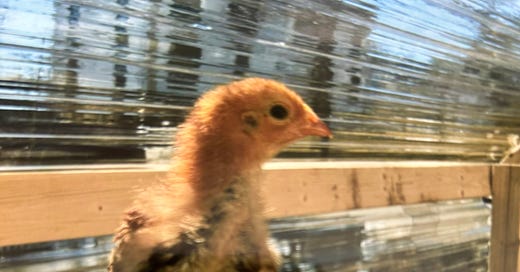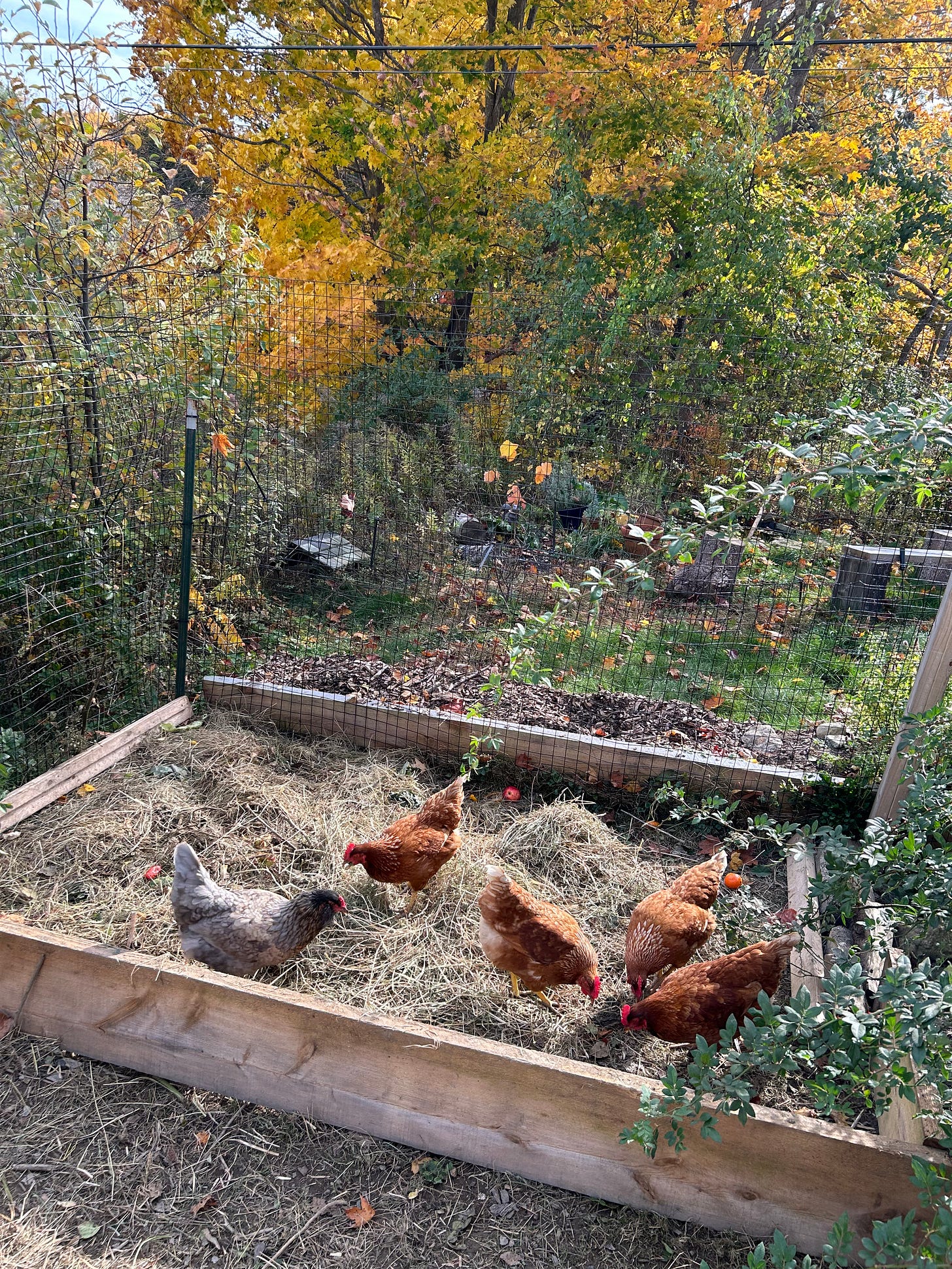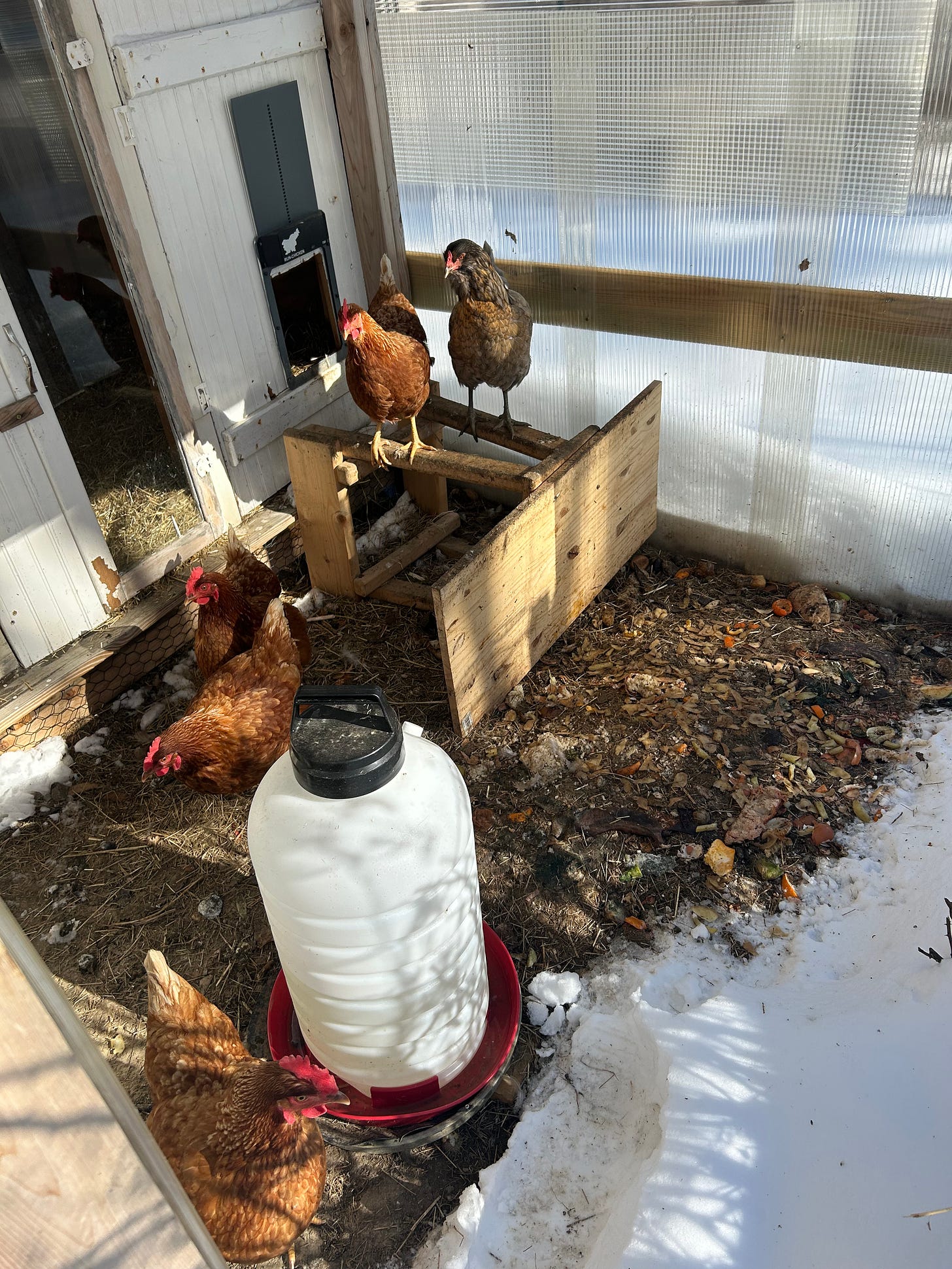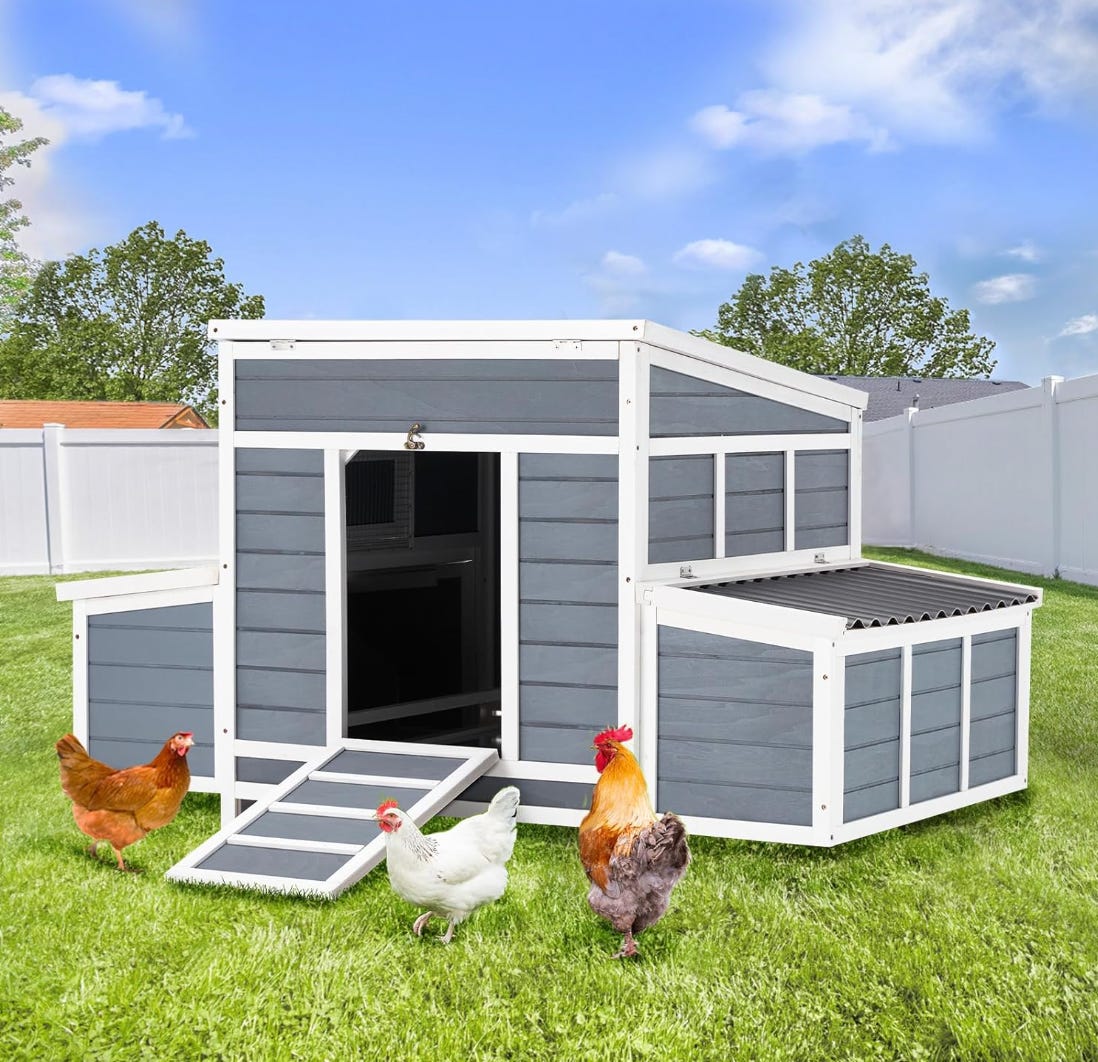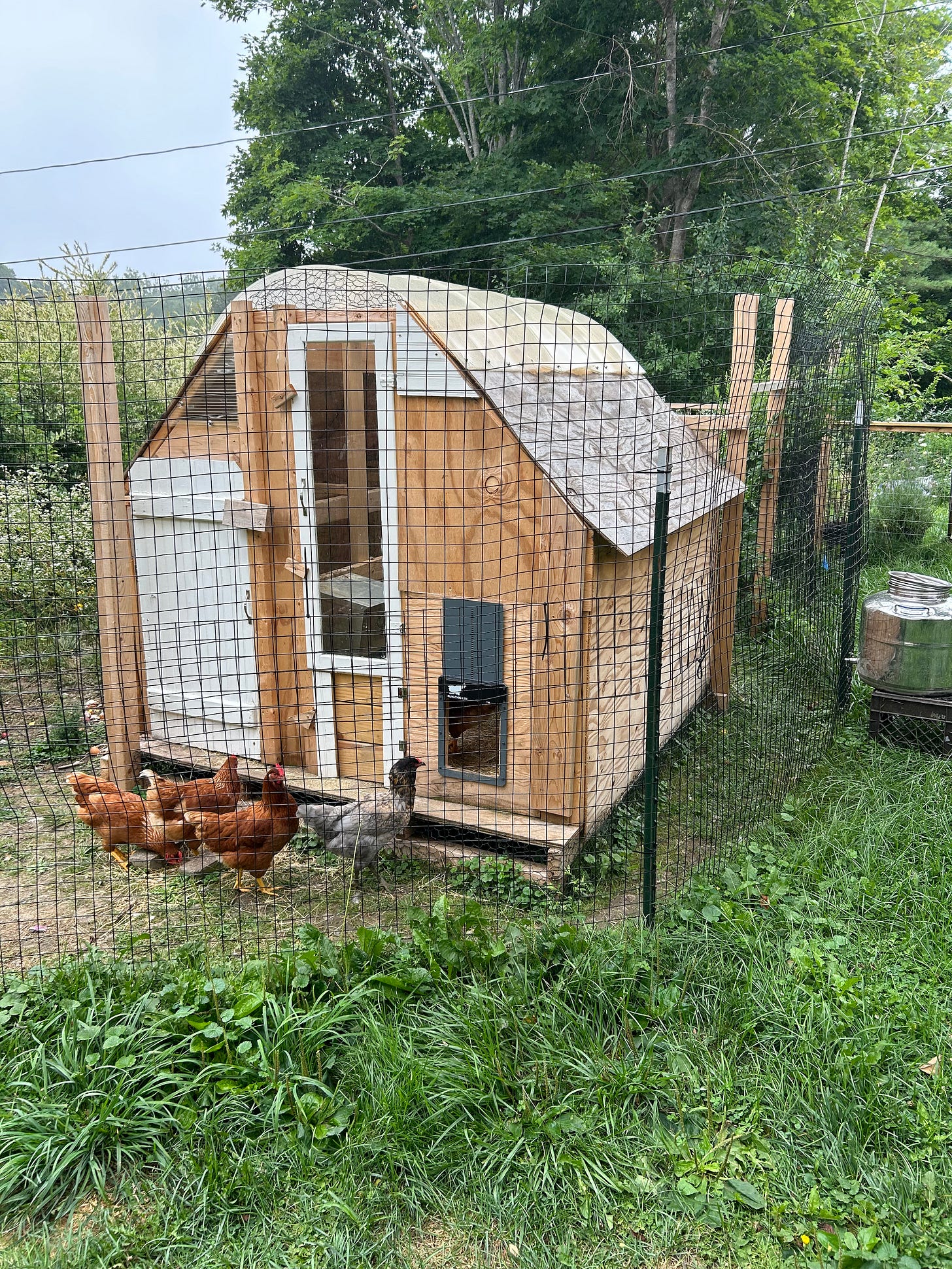The thing about Maine winters is that they are long. Just when you think the snow and cold should be over, they continue. A nice day here and there, interspersed with more snow or sleet or other damp unpleasantness, and then it is mud season for a month. Finally, some time in May, the fine weather starts to hold.
Months before that, of course, you start your seedlings indoors - or attempt to, then give up and spend a great deal of money on young plants at the farmer’s market. You also carefully rear a set of poultry in your basement (or some corner of the house) because you make the mistake of visiting Tractor Supply in March and can’t manage to make it out of the store without a little cardboard box - something like a Happy Meal - filled with chicks.
Good work! You are now ready to start your yardfarm!
Once the pullets are 12-weeks old and fully feathered, and the weather gets warmer, it will be time to get them out of the house and into a coop. Hopefully, before you undertake any of this, you have checked your local ordinances to verify that you can, in fact, keep chickens. If you are in a city or town, you will most likely not be allowed a rooster, and there will be all sorts of setbacks that will determine where you are allowed to site your coop and hen yard. I recommend building the coop within the legal limits, then being more creative in figuring out where to allow your chickens to roam (if you fall under scrutiny, you can always retrofit a legal fence - it is much harder to move or rebuild a coop). The hen yard is supposed to be completely impenetrable (fencing dug into the ground at least a foot deep) to keep the predators and rats out. I have not followed this rule. I make the coop itself impenetrable to predators, and make sure the chickens are locked in the coop from sunset to sunrise. In the daytime, they roam in a large fenced area (five-feet high and touching the ground, but not dug into it). It is possible that predators could get them, but I think the nearby presence of our dogs and cats probably discourages unwanted visitors.
Regarding where to site the coop and hen yard: you MUST be able to see the hens from a window of your house. Preferably the kitchen sink window, or somewhere that you like to sit. The main point of having hens, besides the eggs, is to be able to watch them. They watch you back, as well. Chickens get up to all sorts of business throughout the day. You will want to have a clear sightline, because you will be entertained.
Also, if you tend toward laziness (I am raising my hand) make sure to put the coop within easy shuffling distance from the house. Slopping the chickens and retrieving the eggs on a warm summer morning is a completely different experience than doing so in a snow storm - if you live in a four-season climate, keep this in mind. And if you don’t want the chickens to depend upon human intervention to be let out of the coop in the early hours of the morning, or locked into the coop within a half hour of sundown, do yourself a big, big, big, big, Big, BIG, BIG favor and purchase a battery operated, light-sensitive automatic chicken door.
And once you build your coop, and sometime before it gets too cold (if you are in a northern climate) you will want to construct an attached greenhouse-like shelter, to serve as your Chicken Florida.
But I am getting ahead of myself - I have many ideas for how to go about designing and building all of this.
First of all, if the prospect of building a coop is absolutely beyond your adventure zone, and you have sufficient funds, feel free to purchase. In a panic, during a move, we hired a local carpenter to make and deliver a lovely cedar-shingled coop to our new yard, so the chickens would have an immediate home. It cost $1,200 and the roof leaked, so most of the time it was covered with an ugly tarp.
You can purchase coops over the internet for between $200 and multi-thousands of dollars. I looked around the internet: Amazon, Tractor Supply, Lowes, Home Depot as well as some custom Amish companies, and from exploring the comments, it seems that the coops under $1,500 all seem to advertise greater chicken-housing capacity than any chicken-lover would approve, and the comments suggest that they are not especially solid or long-lasting.
Case in point, this $240 coop on Amazon (listed at $140, but add $100 for delivery) claims to be “large” and boasts six nesting boxes, which would suggest that it would hold six or more chickens. When you multiply the square footage of the open area inside (you do not count the nesting boxes in this calculation), you have 7.5 square feet of floor space. Our local chicken ordinance requires 6’ of floor space per chicken, which would mean that in my town, this coop could legally house one chicken - HOWEVER, our town’s ordinance also requires a minimum of 4’ height for the coop, and this one, shy of 3’, does not qualify. My personal sense suggests that this coop would be ok for two birds, if they had a good outdoor area to inhabit in the daytime. Interestingly, the three comments on this coop all rate it as 5-star, though the first 5-star comment also concedes that the coop is likely to last only about a year, out in the weather.
If you have big pockets, and are determined to purchase a coop ready-made or as a kit, the only company that I can personally recommend (we have purchased three outbuildings from them) is Jamaica Cottage Shop which delivers within the continental United States. This company specializes in timber frame outbuildings, either as kits or fully assembled. The quality is excellent and the kits have very clear directions for assembly. This coop and this coop both look good to me - but you will be looking at an investment of between three and five-thousand dollars.
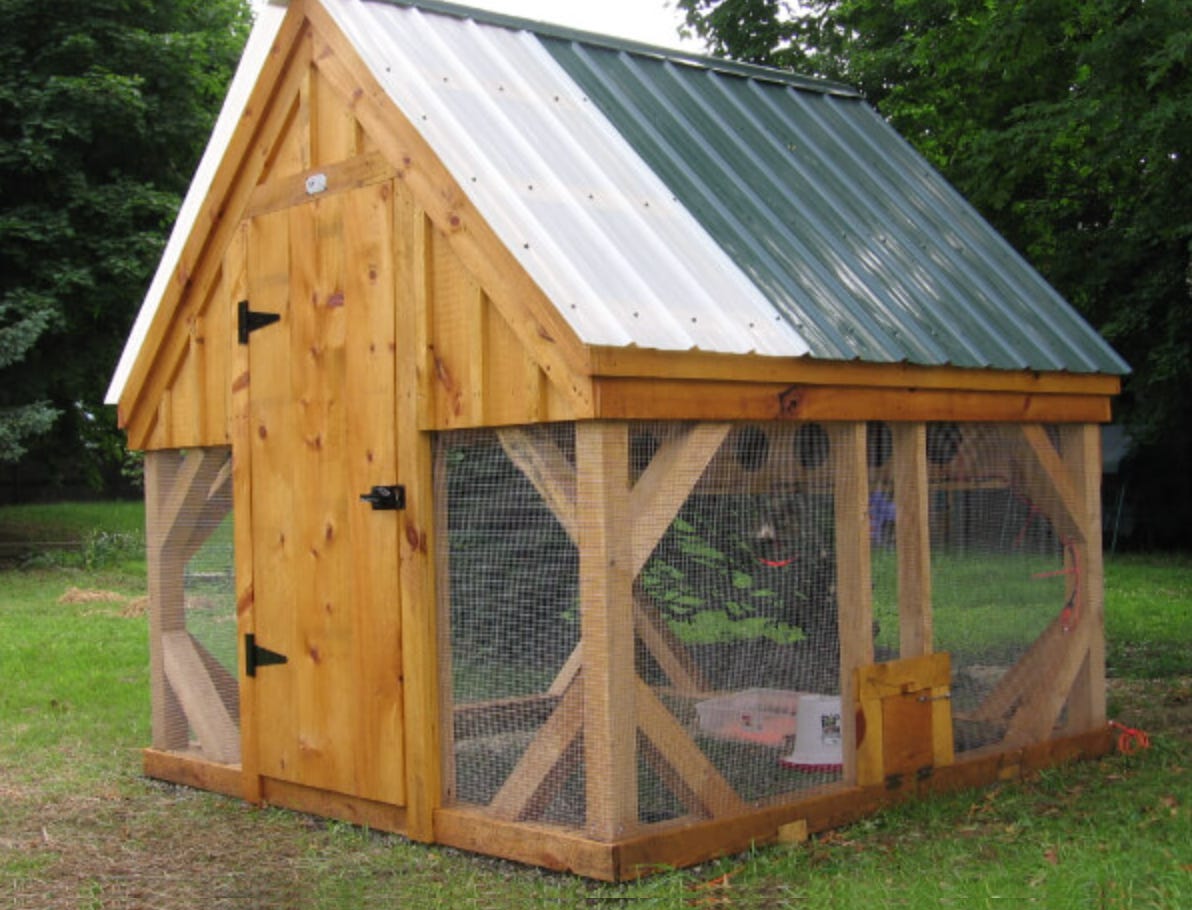
Considering all of that, if you are game for some creative carpentry, designing and building your own coop can be both fun and economical, and your chickens will benefit from adequate room and a weather-tight interior. I speak from experience: our purchased coop, which had to be covered with a tarp, very likely contributed to many of our chickens having frost-bitten crests. This winter, in the coop I built, the girls’ crests have remained pink and happy - and they have continued to lay at least three eggs a day throughout the coldest and darkest weeks (we have five hens - the sixth turned out to be a rooster, so we gave him to friends who have a big farm and flock). The coop took a little over a week to build, and I built it myself, with the exception of my husband digging and placing the corner posts (below frost line for stability.) Made of both scavenged and new material, it cost me roughly $400 to build and offers 36 sq. feet of space, adequate for six hens. The addition of a Run Chicken automatic door, added a month later, brought the total to just over $500.
While this coop satisfies our local ordinance for 6 sq. feet per chicken, my research suggests that it would be fine (and maybe even a little warmer in winter) for nine or ten chickens. I will be posting an article and video outlining the general instructions for building this coop, or adapting a similar one. If I am ambitious, I may also offer a set of plans with illustrations and specific measurements, for a small donation. If I get my act together, it will be ready within a month!
FULL DISCLOSURE! Sometimes I include Affiliate Links in my articles. This means that if you purchase an item from these links, I will receive a small commission. I only ever recommend items or companies that I have used and am VERY happy with - and if I ever link to an item that I haven’t used, I make this clear in the article.


